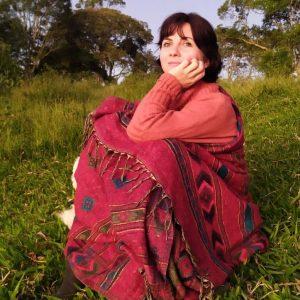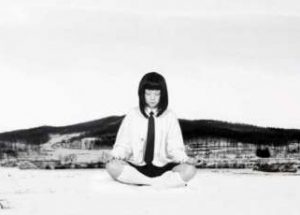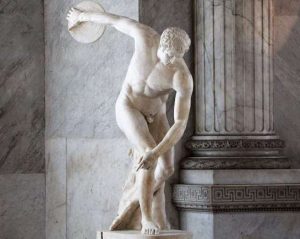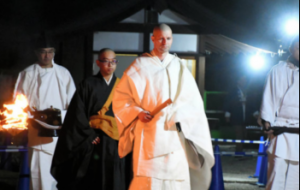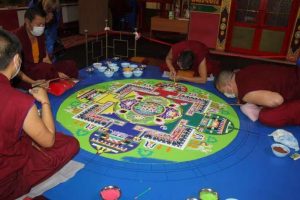I grew up riding horses and I can tell you a lot about them. And they taught me a lot about myself. When I encountered the well-known analogy of the ego being akin to a horse and a “rational self” serving as the commander or rider, I began to observe in myself many layers: there was my wild side and there was my more reasonable side “fighting” to set the rules of the landscape they inhabited.
One thing that horses and riders have in common is that both love freedom. Yet one is tied to the other: the horse needs the rider to give it direction, and the rider depends on the horse to move around.
Let’s imagine that the horse symbolizes the force behind our emotions, our desires and aversions, and our instincts—essentially, what motivates us: desire. A healthy horse desires to live, to love, to be present and curious, and to discern what environment and sustenance suit it best. Conversely, an unhealthy horse is addicted to the intensity of its desires, yearning for sweeter grass, more territory, more beauty, more pleasure, and even more freedom and more recognition. It will do everything in its power to be seen and loved without limits. However, we all know where this unbridle pursuit leads: the prison of cyclic insatiable desires that in Sanskrit is known as samsara.
In many spiritual traditions, it is understood (or misunderstood) that the ego is our enemy and should be destroyed. After all, this “animal” within us can cause so much turmoil. But there is one question we must ask: who is this “I” who is so uncomfortable with the “ego”? Isn’t it just another layer of desire? There’s nothing inherently wrong with desiring; as I noted earlier, it serves as our “horsepower” for navigating life. What truly matter is understanding the nature of the “horse.” And it’s on this point that I’d like to take us on a ride before returning to the original question.

In the constant pursuit of freedom, whatever that means (a topic that also deserves investigation), the “I” within us, which I’ll call the “rider,” gazes at the emotions and desires that live in the shadows, emanating from some karmic directions that we’d rather not face. The rider then denies the very nature of the horse, instead choosing to create beautiful costumes to adorn its steed. It has become common today, for example, to dress up our horse with the appearance of extreme spirituality, holiness, righteousness, positivity, with divine femininity or steadfast masculinity—only the best organic, grass-fed attire. Indeed, the rider takes immense pride and pleasure in crafting all these appearances; it’s so much fun and there are a thousand apps to enable us in this pastime. We exert so much effort, I think, that we all became incredible artists in our pursuit of the perfect image!
Chogyam Trungpa Rinpoche correctly identified this phenomenon as spiritual materialism. The rider has so many tools available to shape the image of the horse into what is desired (or believes is desirable). Yet we know that if a horse is born yellow and we spend our lives painting it brown, or if the horse is born a pony and we attempt to give it the appearance of a Pure Blood Lusitano (those incredible steeds that often appear in medieval films), the effort expended is substantial. More so if it stops being a game and we really believe that our little pony is a Lusitano and we insist on riding the pony up into the mountains as if it had eight legs. Eventually, it will break. Suffering will ensue, along with shame, sorrow, loneliness, and feelings of worthlessness. And this is how so many people feel today—like wounded and weary horses.
Some people slavishly follow the dictates of reason until they fall ill or become constantly angry; reason coerces and controls until, filled with shame, they explode in a shower of repressed emotion.

The inner horse seeks to be loved and accepted by others, most of all by the rider. And as such, it can become overly rebellious or submissive, fixated with the thought of being accepted and loved. Yet this frenzied quest is pursued, without taking the time or having the courage to actually stop, rest, and study who this horse is and what it requires. We must learn to stop, make peace with the horse, that we may, through silent observation, recognize its true color, temperament, and history; its parentage and ancestry; its childhood, its dreams, its motives, without any agenda to “be someone,” and devoid of expectations. Simply put, it requires silent, non-judgmental, impersonal contemplation—in other words, meditation.
This is what it means to meditate: not digging up a pleasing emotion, but exploring and understanding the root of what is arising within us, becoming intimate with the fundamental nature of “the horse,” with which we are for some reason born. The horse that the rider must ride in this life is called karma—although it’s not a conscious choice; more of a consequence. This horse and this rider are bound together as a result of the complex consequences of their ancestral legacy, educational experiences, societal influences, cultural context, era of history, available resources, environmental factors, past lives perhaps, and innumerable other elements that you may have been born with or without.
Of course, we can change our conditions. When the rider truly perceives the horse deeply, it will naturally understand what is beneficial for it. When we lack this deep understanding, we typically seek out and follow external sources of validation, such as digital gurus, YouTubers, self-help books, religion, or whatever some famous and beautiful, or perhaps authoritarian and charismatic, figure is saying . . . or we simply do what mom says.

Of course, such resources can be useful references for reflection and investigation, and we should not ignore all these varied perspectives from diverse sources. But ultimately, the rider and horse should be in an intimate dialogue, engaging with each other, respecting the nature of the other, such that the “final” truth emerges from that vast, silent inner space. The horse and rider may relish adventure, and even a little occasional chaos, but they must know their way back home. Each day they should make their way home and quietly rest in the essence of who they are, being accepting of themselves at the very least.
Not only should we make sure we return to the peaceful embrace of our inner space, we should also allow space for both rider and horse to evolve—to have the freedom and permission to change. If we observe nature, we learn that nothing is permanent and unchanging, including ourselves. And while we may know ourselves intimately, it is essential that we don’t allow ourselves to ossify, because we also need to evolve. We usually change in response to certain experiences. With true awareness, a horse and rider will develop favorable conditions to nurture favorable changes.
Demanding and forcing the horse to conform to preconceived notions is an act of aggression and violence that causes harm to the horse within us. Such situations can arise from adhering to so many external concepts that might not even be true to who we are. But when there is harmony between horse and rider, they can create the conditions conducive to favorable change. How, for example, can we demand that the horse be powerful if the rider only feeds it stale bread? Sometimes, the horse needs the freedom of an expansive green field, while the rider needs time for poetry and music and dance. Therefore, before seeking to change oneself, one should first change the conditions in which the self resides. This is quite a sensible first step toward transformation.

In my view, creating the conditions for a healthy ego is necessary for enabling the horse to take the rider wherever she wants to go. However, this is only one aspect of the whole, because the ego can only experience degrees of freedom—absolute freedom would actually mean dissolution. The ego’s existence is conditional, just like that of a real horse. Everything is in motion, changing, evolving, just like our own existence in samsara, where the “I” exists as the solid, tangible experience with which we are so familiar.
So returning to our original profound question, “Who is experiencing the ego”? “Who is this ‘I’”?
I prefer to avoid using labels. Some might call it “the Higher Self,”“the consciousness,” or “the observer,” but a lot happens when we try to give definitions. There is a deeper layer of self even behind the rider, the “rational” thinker, observing like a spectator. Contemplating more deeply, we discover the observer of the observer. The more deeply one delves into observing the “other,” the deeper “we” go into the abstract and formless. It sometimes feels like the awareness behind all the observers abides unchanging—as the sky contains the space that is inseparable from the self.
Being a visual artist, I will give another example using images. When I observe my body, I discern that I am made of various “parts,” each of which has a very different and specific purpose. My stomach cells, blood cells, and neurons each serve their own unique purpose. When each cell and part of my body adheres to its identity and purpose, this person known as Tiffani can exist. When Tiffani adheres to her identity and purpose—which is different from that of a person in China or any other discrete individual—she helps to form what is known as her family.

Within this family, each member does their own thing, sometimes contradicting and opposing the other members. Yet collectively, Tiffani’s family is a part of a larger group known as Brazilians, which are part of a broader culture known as Latinos. Latinos themselves are one aspect of a world made up of many different nationalities and cultures. Perhaps there are other worlds that are composed of different groups of beings doing their own thing, each of which serve to constitute the universe. It’s even conceivable that there are a multitude of different universes, all of which combine like cells within an infinitely larger body.
At this point, I love to recall one of the meanings of the 30 major and 80 minor marks on the Buddha’s body. These marks describe very precisely that each pore of his skin is a universe, and each curled strand of hair grows in the movement of a galaxy. This is why the Buddha has an infinite number of curled hairs, including the single curled hair we see as a tiny spiral between his eyebrows, reflecting the vastness of existence.
In this sense, this “I” must live as “Tiffani,” yet she is not separate from the universe, or indeed all universes, which brings us back to that well known and beautifully clear analogy of one drop of water being inseparable from the vastness of the ocean.
The concept of the self being layered, like an onion, gives us the freedom to allow Tiffani to be Tiffani, with all of her characteristics, and to be Brazilian, and to be human, and to be a terrestrial creature, an angelic being, and that infinity of stardust floating in the cosmic dance of love that occurs between the massive solar explosions that radiate out from the ultimate power of Creation. “I” can experience joy, freedom, and enlightenment, and can also experience sadness, darkness, and loss . . . infinite space contains infinite possibilities.
Thus, the one who judges whether Tiffani should become a better version of Tiffani is simply the voice of the “rider,” who exists only because the multitude of conditions at this moment conditions support its sense of identity.

In conclusion, this entire “ride” is a simple message to you and to me, telling us to sit in silence. Embrace silence and space. Gaze into the eyes of your horse without judgement; no one can take this journey for you. Exercise your intelligence through your willingness to understand your own nature by your own observation.
Sit quietly without engaging in chatter. Cease decorating and adorning your horse. If your horse is black yet you persist in clothing it in yellow garments and keep insisting that the horse is yellow, this is ignorance.
This is ignorance.
Strip away the layers of your mind. Be unfiltered and naked. Be courageous enough to exist in a space of not-knowing. See the horse as it is. Be intelligent. Be wise. Sit quietly. Simply observe. Simply be aware, without thinking, “this is bad,” “this is good,” “should be this,” “should be that.”
Watch.
Do not be concerned about being “right” or “virtuous.” Be profoundly playful with a deep sense of wisdom and awareness in the intimacy between horse and rider. Stop dictating what the horse should be. Sit and observe, without chattering, without all of your foolish concepts.
Who told you how your horse should be?
When you finally recognize the horse that karma has given you, that life has given you, have fun! Ride! Because then you’re not making anything up; you’re making the best out of this brief existence, out of this fleeting experience of self.
See more
Tiffani Gyatso
Yangchenma Arts & Music
Related features from BDG
Natural Radiance and the Outer and Inner Sun
Life Is Not Useful
Opening to Beauty
Ecstasy: The Path of Joy



